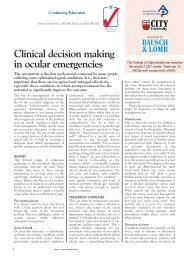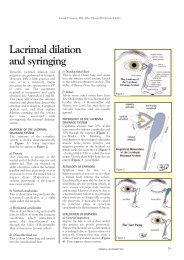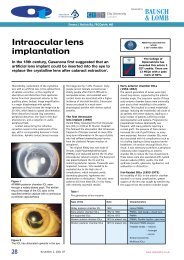Download the PDF
Download the PDF
Download the PDF
You also want an ePaper? Increase the reach of your titles
YUMPU automatically turns print PDFs into web optimized ePapers that Google loves.
CET<br />
CONTINUING<br />
EDUCATION &<br />
TRAINING<br />
THIS ISSUE CET: FREE<br />
✔<br />
✔<br />
Approved for Optometrists Approved for DOs<br />
To gain more standard CET points for this year’s PAYL series, purchase your credits at<br />
www.otbookshop.co.uk and <strong>the</strong>n enter online at: www.otcet.co.uk to take your exams<br />
✘<br />
Sponsored by:<br />
27<br />
< Figure 1<br />
Posterior sub-capsular cataract<br />
Epidemiologic Study.<br />
Outcomes of cataract surgery in<br />
individuals with DM are known to be<br />
poorer, most commonly as a result of<br />
progression of diabetic retinopathy.<br />
However, better control of diabetic<br />
retinopathy with laser treatment prior<br />
to cataract surgery can improve<br />
25, 26<br />
surgical outcomes. Some case<br />
control studies have also demonstrated<br />
that rates of posterior capsular<br />
opacification following cataract<br />
extraction are higher in individuals<br />
27, 28<br />
affected by DM.<br />
Infection<br />
Patients with diabetes are predisposed<br />
to infections. Although not fully<br />
understood, <strong>the</strong> increased rate of<br />
infection seen in patients with DM is<br />
thought to relate to an<br />
immunosuppressive condition brought<br />
about by impaired innate and acquired<br />
immunity. Higher levels of<br />
hyperglycaemia are believed to<br />
correspondingly increase this level of<br />
29, 30<br />
immunosuppression.<br />
One of <strong>the</strong> most devastating<br />
complications following intraocular<br />
surgery is one of acute infectious<br />
exogenous endophthalmitis. This must<br />
be suspected in any patient that<br />
presents a few days after intraocular<br />
surgery with decreasing vision, severe<br />
pain, redness, discharge, conjunctival<br />
injection, anterior chamber<br />
inflammation and vitritis. The<br />
estimated prevalence of presumed<br />
infectious endophthalmitis in <strong>the</strong> UK is<br />
estimated at 1.4 to 1.65 per 1,000<br />
operations 31, 32 and several studies have<br />
shown that patients with diabetes have<br />
an increased risk of developing this<br />
complication. 33-36 The standard<br />
treatment of endophthalmitis is with<br />
intravitreal antibiotics but in resistant<br />
cases, pars plana vitrectomy is<br />
occasionally required. When affected<br />
with endophthalmitis, patients with<br />
DM tend to have a worse outcome<br />
following treatment and usually<br />
require more aggressive management. 37<br />
Endogenous endophthalmitis<br />
(defined as an intraocular infection<br />
resulting from spread from a remote<br />
primary source) is also more common<br />
in diabetic patients. Gram-positive<br />
organisms are <strong>the</strong> most common<br />
bacterial pathogens, especially <strong>the</strong><br />
streptococcal species, including<br />
Streptococcus pneumoniae. Although<br />
relatively rare overall (accounting for<br />
approximately 10% of all<br />
endophthalmitis cases 38 in one series),<br />
nearly a third of cases occurred in<br />
diabetic patients. 39<br />
< Figure 2<br />
Optic nerve changes associated with<br />
glaucoma<br />
Orbital infections account for <strong>the</strong><br />
majority of primary intraorbital disease<br />
processes. Sinusitis is <strong>the</strong> most<br />
common aetiology 40 and diabetes is a<br />
known risk factor for orbital cellulitis. 41<br />
Clinical signs and symptoms include<br />
ery<strong>the</strong>ma and inflammatory changes,<br />
as well as proptosis, injection,<br />
limitation of extraocular motility, and<br />
visual loss secondary to optic nerve<br />
compression.<br />
One serious head and neck infection,<br />
seen almost exclusively in diabetic<br />
patients, is rhino-orbito-cerebral<br />
mucormycosis. Mucormycosis refers to<br />
a group of fungal infections 42, 43 that can<br />
initially present with ophthalmic signs.<br />
Presentation may be as an orbital<br />
cellulitis, an ophthalmoplegia or as an<br />
orbital apex syndrome. 44 An<br />
examination of <strong>the</strong> nose may reveal<br />
necrosis of <strong>the</strong> nasal septum and<br />
turbinates, and <strong>the</strong> patient may<br />
complain of a blood stained discharge.<br />
The condition is an emergency and<br />
must be suspected in individuals with<br />
diabetes as <strong>the</strong> condition rapidly<br />
progresses and is associated with a<br />
high rate of mortality. 45 The treatment<br />
typically consists of a combination of<br />
surgical debridement and an<br />
intravenous anti-fungal agent.<br />
Glaucoma<br />
Glaucoma is a progressive optic<br />
neuropathy associated with typical<br />
optic disc changes (Figure 2) and visual<br />
field defects. Patients with DM are at<br />
risk of two major types of glaucoma:<br />
primary glaucoma and neovascular<br />
glaucoma (NVG).<br />
08/05/09 CET
















